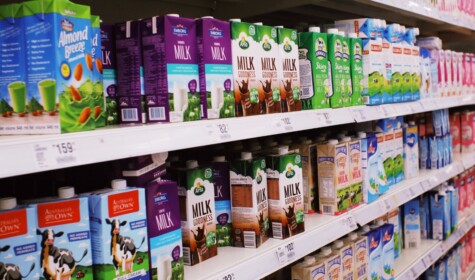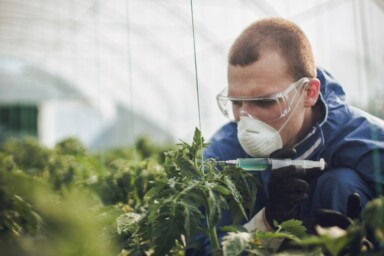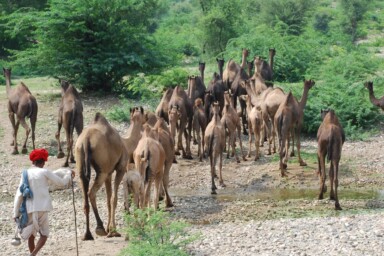Micro dairy and beef farmer Alex Heffron reflects on what influences Millennials’ food choices when it comes to dairy and what the dairy industry needs to do to win them over.
Millennials are choosing to consume less dairy than their parents and grandparents, and more ‘mylk’ alternatives like almond, oat and soya milk. In 2016, the head of Dairy UK, David Dobbin, said that, “It’s a demographic time bomb. If we don’t address the problem now, then we are facing a fall-off in demand for dairy.” Almost a third of Millennials are choosing to cut back on dairy as the dairy-free market continues to grow year on year. How should the dairy industry respond?
According to market research carried out on behalf of The Grocer magazine in 2017, Millennials have three concerns about milk: how healthy it is, animal welfare and its environmental impact. In recent years, the dairy industry has largely responded by trying to convince people that there’s nothing to worry about – that dairy is indeed healthy and that the British dairy industry has world-leading animal welfare standards with farmers being sensitive stewards of our countryside. My desire isn’t to discuss whether the claims and counter-claims are true, but to highlight that the strategy of telling millennials and the wider population that they’re wrong about milk, isn’t working and it’s not an effective PR strategy. Something fundamental must be done to bring Millennials back to milk. Millennials matter because they will influence future generations – fail to change their opinion of dairy and the future of the industry in the UK will be diminished.
The producers of dairy alternatives are taking a different approach. One market analyst said, “Marketers of dairy alternatives generally appear to be doing a better job of connecting emotionally with consumers, who favour more dairy-free options to meet their own perceptions about health and lifestyle.”
I think the dairy industry needs to look at what’s underlying consumer concerns. Why is it, for example, that older generations say dairy is good for them, and younger generations say that it is bad for them? What’s happened in the last couple of decades that’s led to such a wholesale change in opinion? Dairy is still the nutritional food source it always was – after all, northern Europeans are very well adapted to consuming milk thanks to a chance genetic mutation thousands of years ago.
There are three key aspects in changing Millennials attitudes to dairy: connection, identity, and trust. The increasing industrialisation of the food system – from the farming practices themselves, to the sales and distribution of food – has led people away from the food they eat. Increasingly, we see people craving a more direct connection to their food – whether that means buying at the farmers’ market, watching Countryfile or choosing local produce when available in local shops. People get excited about knowing where their food comes from; that might mean opening your farm up to customers or sharing videos on social media. If you’re proud of your farm, then engage people in what you do. People increasingly want their food to come with a face and a name on it. They want food with an identity, particularly Millennials. Millennials, like myself, grew up in an industrialised world of mass-production and they are yearning for something different.
Identity can lead to trust – or lack of it. If your milk is packaged in a bland, plastic bottle and you don’t know what farm, region or even country that it’s produced in and there’s no information about how it’s produced, then it’s hard to trust its provenance. I think farmers underestimate the importance of provenance, as they take knowing where their food comes from for granted. The general public are wanting to know more about their milk, as well as other foods. The dairy industry’s mass marketing campaigns for a nebulous product are missing the point.
The only way forward is for the milk industry to embrace identity, as Nuffield Scholar, Tom Levitt, highlights in his recent report, Put a name on it: Why the future of milk is a branded one. However, this path is littered with pitfalls as the dairy industry would be misguided in believing that a simple ‘re-branding’ of milk would be successful. There needs to be a wholesale change in the industry’s philosophy, away from depicting milk as a bulk commodity – though this will undoubtedly challenge the power structure of the market. Good for farmers, bad for large-scale processors and retailers. Currently, all competition within the dairy market is centred on price, which inevitably puts further pressure on farmers to drive down their cost of production.
More and more, people are getting the sense that dairy is moving in a direction they dislike. Most people want to see cows in fields not barns, most find the shooting of bull calves at birth abhorrent, and most have a sense that dairy is getting too big. Few farmers I’ve spoken to would disagree with any of this. But when they’re being paid a pittance, they have to try everything they can to squeeze another 5p per litre of income out of that cow. Practises such as zero-grazing and shooting bull calves are a small minority, but they’re the canary in the mine. Dairy is going through an identity crisis.
Some small dairy farmers, for example, are responding to this by keeping the calves with their mothers, therefore not weaning the calves until a more natural age. In response to criticisms about the amount of imported feed that dairy cows can consume, some are feeding them solely off pasture.
Another aspect, tied up with identity and connection, that is often ignored, is taste. Tom Levitt highlights in his report that due to standardisation, “dairy producers have had little interest in the distinctive taste of milk that is unhomogenised or from different breeds.” Levitt spoke to the UK’s first milk sommelier (someone who advises which milk to consume or use based on the sort of palate a person has, or what plate of food it is to be paired with), Doug Wood, who said that people don’t even realise that milk can actually have a taste. A food product without taste is a food product without loyalty – this is dairy’s fundamental issue. Yes, the concerns about nutrition, welfare and the environment must be addressed, but dairy must address its lack of value in the eyes of consumers, and this begins with the most basic value of all: taste. After all, how many of us consume products we know are bad for our health and are of questionable ethical source because it tastes good?
The experience my wife and I have had, backs this up. People buy our milk for all sorts of reasons, but the number one thing that excites them is that it has flavour. It’s rich, creamy, sweet, and has a unique texture in the mouth unlike any milk that can be bought from a supermarket. People often end up doubling their order after a few weeks because they get addicted to it. I’m amazed by how many people crave our milk, even if they didn’t ever desire milk in the past. It stops being something they add to their occasional cup of tea – it’s too valuable for that – and they start making smoothies, fancy coffees or just have a pint glass of cold milk straight on a summer’s day. Our milk has become valued by them, which allows us to charge the small premium we do.
There are two basic issues that face farmers and they’re both intertwined. They’re paid too poorly, and they’re undervalued and underappreciated. This is inevitable in a commodity market. The rebranding and relocalisation of milk is an essential first step towards addressing these issues. Farmers will feel better about the work they do, and rightfully get paid more for it. There is a revolution in dairy waiting to happen and some innovative farmers are already starting to reap the rewards. Those who are investing in bottling their own milk, producing their own cheese, yoghurt, or kefir, and connecting with their customers are getting a head start in a completely uncontested marketplace. It can be done on the individual farm level or in cooperatives, but it won’t be achieved in supermarkets. This is a chance for farmers to take back some of the power from large corporations.
This can lead to a fundamental shift in the landscape of British dairy production if dairy farmers act soon. The dairy-free, milk alternatives industry is continually eating into the dairy market, and that’s because they better understand what people want, particularly Millennials. If British dairy wants to win back the Millennials, and consequently all future generations, it must embrace the benefits of connection, identity and trust. This would be a win-win for producers and consumers.







